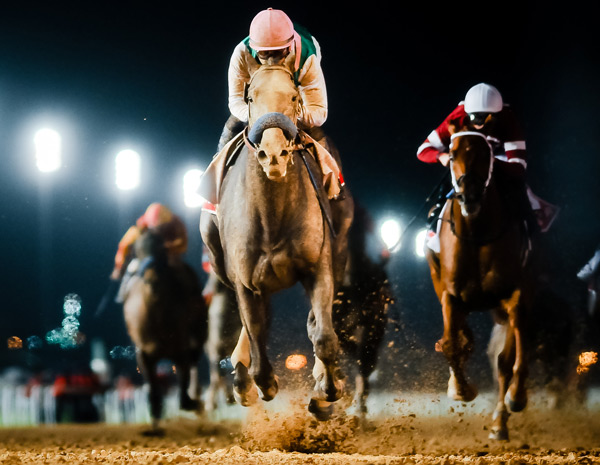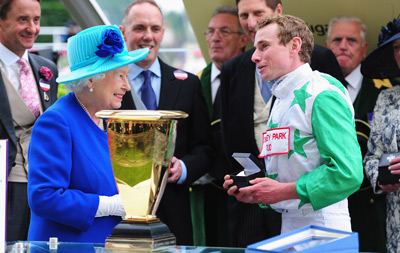 |
American thoroughbred Arrogate comes from behind to win the Dubai World Cup.
Photo by: GETTY IMAGES |
For years, NBC was focused on broadcasting horse racing’s Triple Crown events, including Saturday’s Kentucky Derby, which often draws the biggest rating for a sporting event in the second quarter of the year.
NBC, which also broadcasts the Breeders’ Cup World Championships in the fall, has doubled down on horse racing in recent years. This year, for the first time, three international events — the Dubai World Cup from the United Arab Emirates, and the Epsom Derby and Royal Ascot from England — will air on NBC Sports Network. The Dubai World Cup aired March 25 and featured the gray American thoroughbred Arrogate beating a field of 14 of the world’s best racehorses.
“We had 200,000 people watching the $10 million Dubai World Cup at 10 o’clock in the morning,” said Jon Miller, NBC Sports president of programing. Miller said that he was pleased with the number but has even higher hopes for NBC’s first broadcast of Royal Ascot, in June of this year.
“Royal Ascot is going to be the one that surprises a lot of people by just how much attention it gets,” Miller predicted. NBCSN will air five days of racing from Ascot Racecourse’s Royal meeting, where Grade 1 races are run every day and Queen Elizabeth II attends each day of racing.
Horse racing has been criticized as a provincial, old-fashioned sport. But more than ever, the sport’s stakeholders are investing money to expand globally. That includes networks, including NBC and the horse racing channel TVG spending time and money to broadcast races from England, Dubai and Australia, as well as tracks offering money to entice the best foreign horses to run in big races in the U.S.
While betting on horse racing in the U.S. has been flat the last few years, it is growing in other parts of the world, including Hong Kong, where the amount of money wagered on races increased from about $7.71 billion in 2006 to about $14.81 billion this past year.
“These are all markets where horse racing is growing, and it’s not growing in the United States,” said Kip Levin, TVG chief executive officer. “Everybody’s interested in taking from what is happening in these international markets, learning from that and seeing how we can bring it back here and how can we put the sport in front of a broader audience.”
TVG, which reaches 45 million U.S. homes, recently announced an agreement with its Australian counterpart, Sky Racing, to offer enhanced coverage of horse racing in Australia, Levin said.
TVG had previously aired racing from Australia, but without commentary or narrative around it, Levin said. “What we have done is we have brought in a couple of experts on Australian racing,” he said. “They are the hosts of the show, and we are currently teaching the American public through TVG about Australian racing.”
In the first three weeks under the new enhanced format, the wagering conducted via TVG on Australian races has increased 40 percent, Levin said. TVG is also looking at the possibility of doing the same thing in other global markets.
 |
Queen Elizabeth II congratulates a winning jockey last June at Royal Ascot.
Photo by: GETTY IMAGES |
Meanwhile, tracks are doing all they can to attract foreign horses.
For racehorse owners, winning the Kentucky Derby is the ultimate accomplishment, even though its $2 million purse is nowhere near the richest in the world. To get a horse in that 20-slot gate, an owner has had to run and win, place or show in certain top American races for 3-year-old horses — until this year.
Churchill Downs has unveiled a “Japan Road to the Kentucky Derby,” which allows horses that run well in two stakes races in Japan to qualify for the Derby. That’s because of Japan-based horse Lani, who entered and ran in the Kentucky Derby in 2016.
“When Lani was here, he was almost like a sensation,” said Mike Ziegler, Churchill Downs executive director of racing. “A lot of media from Japan came to visit and report on the Derby. We sort of realized when he was here and got all this attention and we saw that racing was a global sport and we should have participation from horses in Japan every year in the Derby.”
The New York Racing Association went one better, by not only reserving a spot in the gate for the Belmont Stakes, the third leg of the Triple Crown, but offering a whole lot of money for a Japan-based horse to run. In January, NYRA announced it would give any Japan-based horse a $1 million bonus on top of the $800,000 winner’s share of the purse if that horse wins the Belmont Stakes, the third leg of the Triple Crown.
NYRA is not only looking to bring in horses from Japan. In March, it announced a partnership with Berlin-based Hoppegarten Racecourse in which winners of two of its races will be given an all-fees-paid invitation to compete in New York races, the Belmont Oaks Invitational, for 3-year-old fillies, and the Belmont Gold Cup Invitational, for older horses.
It used to be that American race fans could not see the best horses from overseas except in the Breeders’ Cup races, horse racing’s championship event. Some of the best horses in Europe, South America and Asia have come to the U.S. to compete in some of those championship races, which have purses of $1 million or more. The Breeders’ Cup has increasingly been working on ways to bring more international horses to the U.S. and this year has included 32 races in 11 countries overseas as qualifiers for its 13 championship races.
The Breeders’ Cup will pay the shipping and entry fees for horses winning those races, which are being run in Argentina, Australia, Brazil, Chile, England, France, Ireland, Japan, Germany, Peru and South Africa.
Meanwhile, Breeders’ Cup executives have been meeting with executives from English tracks Ascot and Goodwood Racecourse, Australia’s Flemington Racecourse and Dubai’s Meydan Racecourse about the possibility of forming a coalition to sell sponsorships and other business opportunities, said Bryan Pettigrew, Breeders’ Cup senior vice president of marketing and sponsorships.
So far they have had three meetings — in the U.S., Dubai and Europe — to discuss selling sponsorships around their high-end horse racing events, including Royal Ascot, the Melbourne Cup and the Dubai World Cup. Things are in the planning stages, but Pettigrew says, “We hope to have an announcement this summer.”





